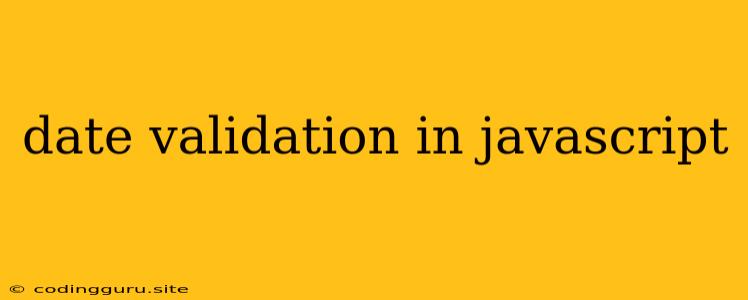Date Validation in JavaScript: Ensuring Accurate Input
Validating user input is a crucial aspect of building robust web applications. When dealing with dates, it's essential to ensure that the entered value is a valid and correctly formatted date. JavaScript provides various tools and techniques to effectively validate dates, preventing potential errors and inconsistencies in your data.
Why is Date Validation Important?
- Data Integrity: Incorrect date formats or invalid dates can lead to errors in data processing, calculations, and analysis.
- User Experience: Clear error messages and validation help guide users towards providing accurate information, improving their experience.
- Security: Date validation can help prevent potential vulnerabilities by preventing malicious inputs that could exploit date handling in your application.
Common Approaches to Date Validation
1. Using Regular Expressions (Regex)
Regex offers a flexible way to validate date formats. You can create a regex pattern that matches the desired format. However, regex validation alone might not cover all date validity checks (like leap year considerations).
function validateDate(dateString) {
// Regular expression for YYYY-MM-DD format
const regex = /^\d{4}-\d{2}-\d{2}$/;
return regex.test(dateString);
}
const date1 = "2023-03-15"; // Valid
const date2 = "2023-02-30"; // Invalid
console.log(validateDate(date1)); // true
console.log(validateDate(date2)); // false
2. Leveraging JavaScript's Date Object
The built-in Date object provides powerful methods for date manipulation and validation. You can create a Date object from the input and check if it's a valid date.
function validateDate(dateString) {
const date = new Date(dateString);
return !isNaN(date.getTime()); // Returns true if the date is valid
}
const date1 = "2023-03-15"; // Valid
const date2 = "2023-02-30"; // Invalid
console.log(validateDate(date1)); // true
console.log(validateDate(date2)); // false
3. Third-Party Libraries
Libraries like Moment.js and Date-fns offer comprehensive date manipulation and validation tools. They simplify date handling and provide convenient methods for validating dates.
Example using Moment.js:
// Install Moment.js: npm install moment
const moment = require('moment');
function validateDate(dateString) {
return moment(dateString, 'YYYY-MM-DD', true).isValid();
}
const date1 = "2023-03-15"; // Valid
const date2 = "2023-02-30"; // Invalid
console.log(validateDate(date1)); // true
console.log(validateDate(date2)); // false
Tips for Effective Date Validation
- Define a clear date format: Specify the expected date format (e.g., YYYY-MM-DD, DD/MM/YYYY) and use appropriate validation methods.
- Handle different locales: Consider supporting various date formats used in different regions.
- Implement user feedback: Provide clear error messages when the entered date is invalid. Use tooltips or inline validation to guide the user.
- Test thoroughly: Validate dates across different browsers and devices to ensure consistent behavior.
Conclusion
Validating dates in JavaScript is essential for maintaining data integrity, improving user experience, and ensuring the security of your applications. By leveraging JavaScript's built-in features, regular expressions, or third-party libraries, you can implement robust date validation mechanisms that protect your applications from invalid data.
